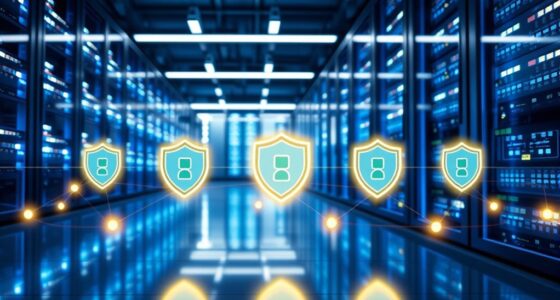To secure your remote and hybrid workforce, implementing cloud IAM offers centralized control over user access, reducing vulnerabilities across various devices and locations. It enforces security policies like multi-factor authentication, enables instant permission updates, and provides detailed activity monitoring. This flexibility strengthens your security posture, guarantees compliance, and minimizes risks of insider threats and data breaches. Keep going to discover how cloud IAM can help you build a resilient and secure work environment that adapts to your evolving needs.
Key Takeaways
- Centralized identity management ensures consistent access control across all remote and hybrid work locations.
- Multi-factor authentication (MFA) enhances security for remote login attempts and access to sensitive data.
- Dynamic permission updates allow instant adjustments to user roles as organizational needs evolve.
- Continuous activity monitoring provides visibility to detect and respond to suspicious or unauthorized access.
- Automated security policies and compliance enforcement reduce vulnerabilities and simplify regulatory adherence.

Have you ever wondered how to keep your organization’s data safe when your team works remotely or in a hybrid setup? With employees accessing sensitive information from various locations and devices, traditional security measures often fall short. That’s where Cloud Identity and Access Management (IAM) steps in to provide a robust solution. Cloud IAM allows you to centrally manage user identities, control access permissions, and monitor activities across your entire organization. By leveraging cloud-based tools, you eliminate the vulnerabilities associated with on-premises systems and create a more flexible, scalable security framework.
Implementing Cloud IAM means you can set precise access controls based on roles, departments, or specific projects. Instead of granting blanket access, you ensure each team member only sees what’s necessary for their work. This principle of least privilege minimizes the attack surface and reduces the risk of accidental data leaks or malicious insider threats. You can also enforce multi-factor authentication (MFA), adding an extra layer of security that verifies user identities beyond just passwords. MFA is especially critical in remote environments where credentials may be more vulnerable to phishing or theft.
Set precise access controls and enforce multi-factor authentication to protect remote work environments.
Another advantage of Cloud IAM is its ability to adapt to your evolving workforce. As your team grows or shifts roles, you can instantly update access rights without the need for manual configurations on individual devices. This dynamic management prevents outdated permissions from lingering and potentially exposing your data. Additionally, with centralized logging and activity tracking, you gain visibility into every login, file access, or administrative change. Monitoring these actions helps you spot unusual behavior early and respond swiftly to potential security incidents.
Cloud IAM also simplifies regulatory compliance by providing detailed audit trails and enforcing security policies consistently across all users. When working remotely or in hybrid environments, compliance can be complex, but cloud solutions help guarantee you meet industry standards and data protection regulations. Integration with other security tools, such as endpoint protection or threat detection systems, enhances your overall security posture. You can automate responses to suspicious activity, further safeguarding your organization against cyber threats.
Furthermore, understanding the importance of project-specific access allows organizations to tailor permissions more effectively, reducing unnecessary exposure. In essence, securing your remote and hybrid workforce through Cloud IAM isn’t just about technology—it’s about creating a security culture that prioritizes control, visibility, and flexibility. It empowers your team to work efficiently without compromising security, giving you peace of mind that your data remains protected regardless of where your employees are working from. As remote work continues to evolve, adopting Cloud IAM becomes a strategic move that aligns your security practices with modern work trends, ensuring your organization stays resilient and secure in a rapidly changing digital landscape.
Frequently Asked Questions
How Does Cloud IAM Integrate With Existing Security Protocols?
Cloud IAM integrates seamlessly with your existing security protocols by using APIs and standard authentication methods like SAML, OAuth, and OpenID Connect. You can enforce policies, manage user access, and authenticate identities centrally, ensuring consistency across all systems. It complements your current security measures, enabling you to monitor access in real-time, reduce risks, and adapt quickly to new threats, all while maintaining a smooth, unified security framework.
What Are the Cost Implications of Deploying Cloud IAM Solutions?
Imagine building a fortress with flexible bricks; deploying cloud IAM solutions involves costs that vary based on your needs. You’ll face initial setup fees, subscription charges, and potential expenses for integration and training. While cloud IAM can be cost-effective over time, it’s essential to weigh these investments against the security benefits. You can control costs by choosing scalable plans, ensuring you only pay for what you need, like tailoring your fortress to fit your budget.
How Can Organizations Ensure Compliance With Data Privacy Laws Using Cloud IAM?
You can guarantee compliance with data privacy laws by implementing strong access controls, regularly auditing user permissions, and enforcing multi-factor authentication. Use cloud IAM to monitor and log all access activities, which helps identify potential breaches. Keep policies up-to-date with evolving regulations, and train your staff on data privacy practices. Automate compliance reporting within your IAM solutions to demonstrate adherence and quickly respond to any legal requirements.
What Are Best Practices for Onboarding Remote Employees Securely?
Start securely with a structured, streamlined onboarding process. You should verify identities vigilantly, provide precise permissions, and prioritize password policies. Prepare extensive training, and promote proactive communication to prevent pitfalls. Implement multi-factor authentication, monitor movements meticulously, and maintain meticulous documentation. By blending boldness with best practices, you establish a solid security foundation, ensuring remote employees integrate seamlessly while safeguarding sensitive data and system integrity.
How Does Cloud IAM Handle Multi-Factor Authentication Across Different Devices?
Cloud IAM handles multi-factor authentication across different devices by requiring you to verify your identity through multiple methods, such as a password plus a fingerprint or a one-time code sent to your phone. It seamlessly adapts to various devices, ensuring consistent security whether you’re on a laptop, tablet, or smartphone. This layered approach protects your accounts, making it harder for unauthorized users to gain access, no matter what device you’re using.
Conclusion
By securing your remote and hybrid workforce with cloud IAM, you protect sensitive data and strengthen overall security. Did you know that 82% of organizations report increased security risks with remote work? Adopting cloud-based identity access management guarantees you stay ahead of threats, maintain productivity, and build trust with your team. Embrace these solutions now to keep your workforce safe and your business resilient in today’s evolving digital landscape.









